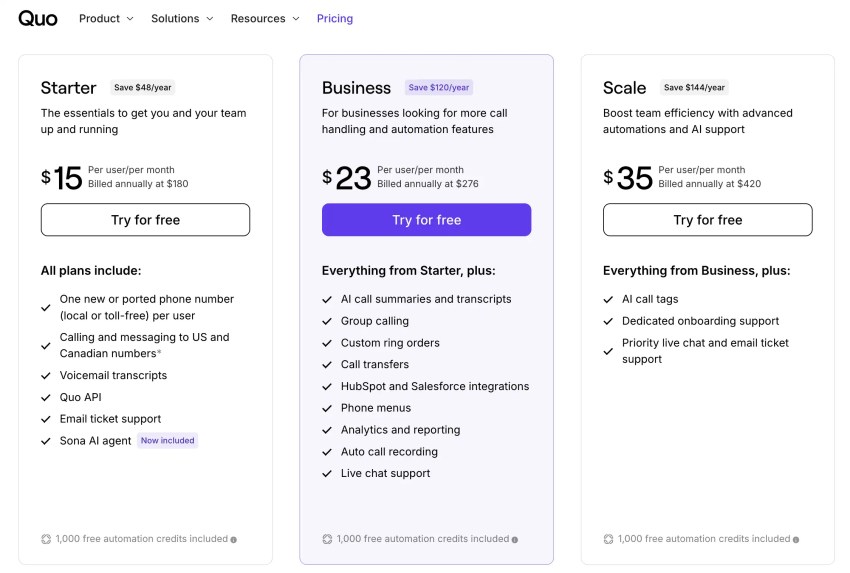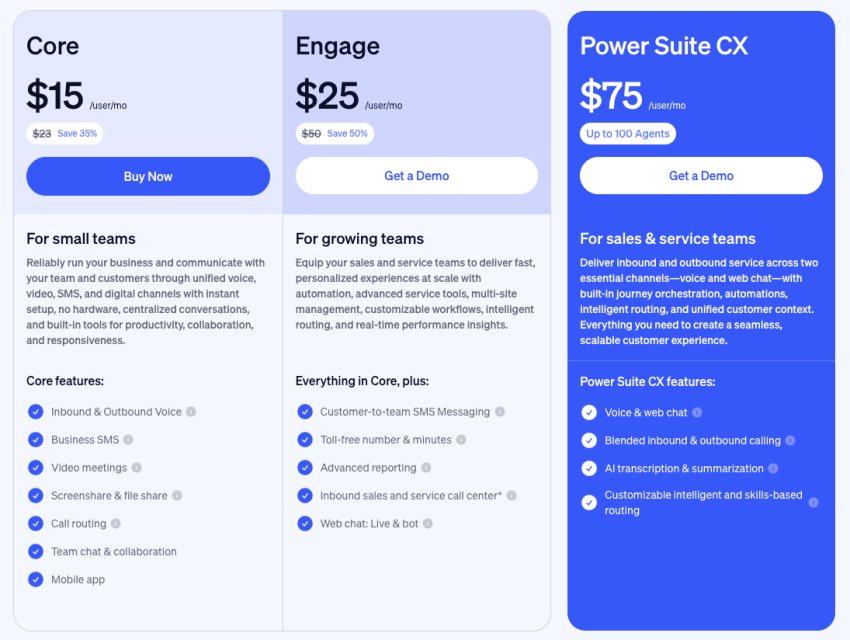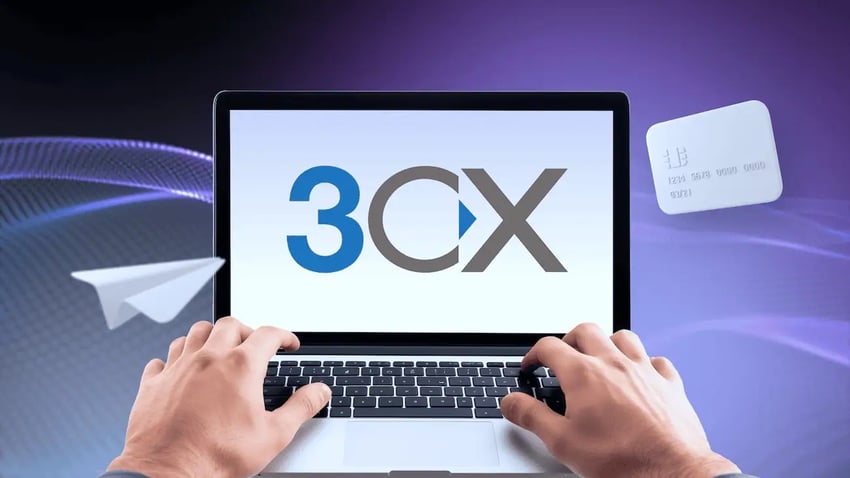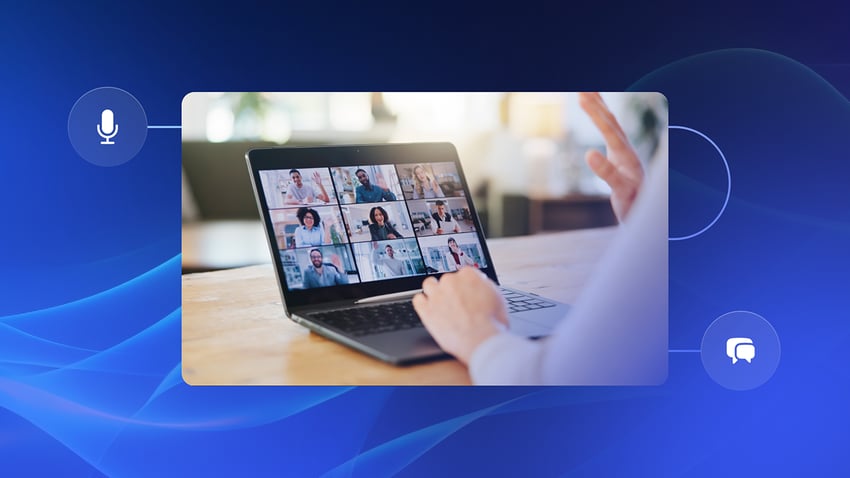Choosing the right business phone system isn’t just about finding the lowest price, it’s about balancing features, reliability, and support.
Many SMBs compare OpenPhone and Nextiva, and at first glance, OpenPhone pricing seems like the more affordable option. But a lower price doesn’t always mean better value. 79% of CX leaders say their leadership views customer experience as a revenue driver, not a cost center, making long-term platform value more important than sticker price.
So what do you actually get for your money? Let’s take a closer look at how OpenPhone pricing stacks up against Nextiva, and where it falls short.
Note: OpenPhone has rebranded to Quo, which we’ll use throughout the rest of the article.
Key Takeaways
- Quo pricing includes three plans: Starter ($15 per user/month), Business ($23 per user/month), and Scale ($35 per user/month). It’s designed for startups and small businesses that need straightforward calling, texting, and shared phone number.
- Strengths: Quo offers quick setup, an intuitive interface, Sona AI agent, voicemail transcription, free porting an existing phone number, and unlimited calling and messaging within the U.S. and Canada (subject to fair usage limits).
- Limitations: It lacks built-in video calling, VoIP hardware compatibility, and 24/7 support—features that Nextiva includes even in its entry-level plan.
- Bottom line: Quo is ideal for smaller teams prioritizing affordability and simplicity, while Nextiva delivers greater long-term value for growing businesses that need a complete, scalable communications platform.
Quo Plans & Pricing
Quo (formerly OpenPhone) is a cloud-based communications platform that offers voice and messaging capabilities for businesses of all sizes. It’s a reliable service with basic functionalities that may be perfect for a small- or medium-sized business (SMB).
Let’s dive into their pricing plans.

Starter plan: $15/month per user (billed annually)
The Starter plan is ideal for small businesses that have relatively simple communication needs and don’t conduct significant business communications outside the U.S. or Canada.
Features of the Starter plan include:
- One new or ported phone number (local or toll-free) per user
- Calling and messaging to US and Canadian numbers (subject to fair usage limits)
- Shared phone numbers up to 10 paid users
- Manual call recording, auto-replies, and scheduled messages
- Voicemail transcripts
- Quo API
- Email ticket support
- Sona AI agent (now included)
- Integration with email, Slack, Zapier, Make, Google Contacts, and Webhooks (beta)
- Email ticket support
Business plan: $23/month per user (billed annually)
This plan can benefit SMBs that plan to grow or those that need slightly more advanced and collaboration-focused features.
The Business plan includes everything in the Starter plan, plus:
- AI call summaries and transcripts
- Group calling
- Custom ring orders
- Call transfers, advanced call forwarding
- HubSpot and Salesforce integrations
- Phone menus
- Analytics and reporting
- Auto call recording
- Unlimited paid shared phone numbers
- Live chat support
Scale plan: $35/month per user (billed annually)
The Scale plan can benefit scaling SMBs or large businesses that may need additional support or customization options. However, it doesn’t offer many more benefits than the Business plan.
The Scale plan includes everything in the Business plan, plus:
- AI call tags
- Dedicated onboarding support
- Priority live chat and email ticket support
Add-ons (across all plans)
Quo customers can choose from any of the following add-ons to include in the monthly plan of their choice:
- Additional phone numbers: $5 per number, per month (billed annually)
- International calling and messaging: Billed per minute or per message rate based on the destination. Billed using credits.
- Automated messages via Zapier: $0.01 per outgoing text message
- Automated messages via API: $0.01 per segment
Nextiva Plans & Pricing
Nextiva’s pricing model offers more flexible plans and a relatively affordable entry tier, with more advanced plans adding functionality. This makes Nextiva a strong choice for businesses that want to scale, as its pricing – transparent, without hidden fees – remains affordable alongside growth.
For the best rate, we recommend selecting an annual billing option, as shown below. Remember, you can change your service anytime, so if you find that your current plan no longer suits your growing needs, reach out to your Client Success Manager.
Start calling for just $15/month
See why over 100,000 businesses switched to Nextiva. Now you can get it all for $15/month per user. Nextiva also offers contact center solutions for businesses with growing support or sales teams.
The following subscription tiers accommodate diverse business requirements:
- Core Package ($15/month): Offers small teams robust features through unified voice, video, business SMS, and digital channels with instant setup, no hardware, centralized conversations, and built-in tools for productivity, collaboration, and responsiveness.
- Engage Package ($25/month): Offers advanced features like customer-facing texting, a toll-free number, speech analytics, automation, advanced service tools, multi-site management, customizable workflows, intelligent routing, and real-time performance insights.
- Power Suite CX ($75/month): The most comprehensive option for sales and service teams, including intelligent routing algorithms, skills-based routing, built-in journey orchestration, automations, AI transcription & summarization, integration with CRM and CDP systems, and advanced supervisor dashboards for performance tracking and analysis.
Each of the higher plans offer incremental value, allowing businesses to choose the level of service that best aligns with their customer engagement strategy and operational needs.

Which Nextiva plan is best?
Nextiva Power Suite CX offers the most features and functionality for small- and mid-size companies. In addition to extensive business communication features, it provides advanced basic call center functionalities.
If you have a smaller budget, check out the Nextiva Core plan for essential business communication features like unlimited calling nationwide, IVR, business SMS, and more. You also get a mobile and desktop app at no extra cost for the freedom to work from anywhere.
And suppose you want to connect your on-premises PBX to Nextiva. In that case, we offer flexible SIP trunking as low as $14.95 per month.
Start calling for just $15/mo.
See why over 100,000 businesses switched to Nextiva. Now you can get it all for $15/month per user.
Top Features: OpenPhone vs. Nextiva
When comparing Quo pricing to Nextiva’s, it helps to see what each plan actually includes. The table below highlights the most important features in each provider’s entry-level plan so you can easily compare value at a glance.
| Feature or Functionality | Quo Starter Plan | Nextiva Core Plan |
|---|---|---|
| Monthly price per user when billed annually | $15 | $15 |
| Hardware phone compatibility (VoIP phones) | ❌ | ✅ |
| Unlimited voice calling (U.S. and Canada) | ✅ (subject to fair usage limits) | ✅ |
| Mobile apps (iOS and Android) | ✅ | ✅ |
| Video calling functionality | ❌ | ✅ |
| Video conference functionality | ❌ | ✅ |
| Meeting scheduling | ❌ | ✅ |
| Team messaging | ✅ | ✅ |
| Call recording | Manual | Add on |
| Free number porting | ✅ | ✅ |
| Business SMS | ✅ | ✅ |
| Voicemail transcription | ✅ | ✅ |
| Analytics and reporting | ❌ | ✅ |
Overall, Quo’s Starter plan focuses on affordability and essential communication tools, while Nextiva’s Core plan includes more advanced capabilities—like video conferencing, analytics, and hardware phone support—at a similar price point.
Which Provider Offers the Best Value for Your Business?
Choosing between VoIP providers like Nextiva and Quo ultimately comes down to your communication needs, budget, and growth plans. According to Nextiva CX research, 94% of companies report seeing ROI from their CX investments over the past five years.
- Quo is a good fit for startups or small teams that mainly rely on voice and SMS, need a shared number, and want an affordable entry point. Its lower pricing and simple interface make it appealing for lean operations—but you’ll need a separate tool for video conferencing or more advanced analytics.
- Nextiva, by contrast, offers a more comprehensive communications suite—voice, video, messaging, analytics, and integrations—right from the start. While its plans cost more, the all-in-one value, scalability, and 24/7 support make it a stronger long-term investment for growing or established businesses.
Final Verdict: Quo vs. Nextiva
When it comes to OpenPhone pricing, the platform offers an attractive entry point for small businesses that primarily rely on calling and texting. It’s simple, affordable, and easy to set up. However, for growing businesses that need a more comprehensive communications system—with built-in video conferencing, analytics, and hardware compatibility—Nextiva delivers far greater long-term value.
Both platforms have their strengths, but if you want reliability, scalability, and 24/7 support from day one, Nextiva stands out as the more complete business communications solution.
Start calling for just $15/mo.
See why over 100,000 businesses switched to Nextiva. Now you can get it all for $15/month per user.
OpenPhone FAQs
OpenPhone’s pricing starts at $15 per user per month (billed annually) for the Starter plan, which includes unlimited U.S. and Canada calling and texting, voicemail-to-text, and shared numbers. The Business plan costs $23 per user per month and adds features like call recording, analytics, and IVR menus, while the Scale plan for larger teams costs $35 per user per month. An additional number costs $5 per month each, and international calls or messages are billed separately per destination.
The best alternative depends on your business needs. Nextiva is stronger for larger teams needing advanced call routing, analytics, and unified communications. RingCentral and Dialpad offer richer AI, video, and integration features, while Google Voice or Grasshopper may be better for individuals or small teams with basic needs. If you want deeper reliability, priority support, or enterprise scalability, Nextiva generally outperforms OpenPhone.
Yes, OpenPhone supports international calling and messaging, but only calls and texts within the U.S. and Canada are unlimited. For other countries, rates vary by destination and are billed per minute or per message. Availability differs depending on the country, so users planning frequent international communication should check OpenPhone’s rate tables before use.
OpenPhone is built specifically for modern businesses, offering shared numbers, call routing, integrations with tools like HubSpot and Slack, and team collaboration features. Google Voice, meanwhile, is simpler and integrates seamlessly with Google Workspace but lacks advanced analytics, shared inboxes, and CRM integrations. In short, Google Voice suits basic or individual use, while OpenPhone is better for growing teams that need more professional capabilities.
OpenPhone offers a free seven-day trial before requiring you to select one of its pricing plans. This trial period allows users to experience how OpenPhone works with its full suite of features.
OpenPhone operates as a VoIP (Voice over Internet Protocol) service, leveraging internet connectivity to facilitate customer communications. This means that instead of relying on traditional telephony networks, OpenPhone transmits voice and multimedia content over the internet.

















 VoIP
VoIP 









